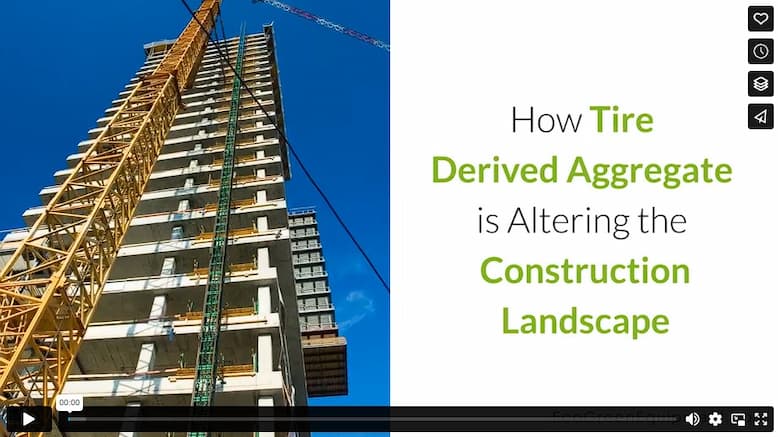Tire-derived aggregate (TDA) is a low-cost substitute for stone, soil, and other common construction materials that is finding its way into an increasing number of construction projects. It is a low-cost alternative that, in many situations and applications, outperforms these traditional fill materials.
Intended for use in civil engineering projects, TDA consists of scrap tire shreds that range in size from 2-12 inches. Although it may also be referred to as tire chip or shred, these terms can lead some to confuse it with other scrap tire products with different intended uses. The specific specifications for a shipment of TDA will vary depending on the project. Contractors may specify a desired shred size based on environmental, technical, or structural requirements for the job at hand.
Benefits of Using TDA in Construction
• Short Processing Time – Producing quality TDA requires less processing when compared with other tire-derived products. A single pass through the primary shredder can produce the tire shreds from whole car and truck tires. Adjusting the size of the gap between the shredding blades in the primary shredder can change the size of the resulting shreds to meet customer needs.
Producing high-quality TDA depends on maintaining sharp blades within the primary shredder. Dull blades cannot cut cleanly through the thick rubber and may dislodge tire wires as the blades tug and pull at the raw material. Advances in the design of tire recycling equipment allow technicians to rotate blades easily, making use of every sharp edge before needing to replace blades entirely.
• Inexpensive – Compared to other fill products used in construction, such as soil, gravel, or stone, tire-derived aggregate costs less for the same volume of product. Using TDA can help reduce the cost of extensive projects.
• Uses Large Volumes of Tires – Huge construction projects such as building and repairing roadways and laying track for light rail require large volumes of materials. Each ton of TDA is approximately 1.5 cubic yards and represents 100 tires. Thus, every cubic yard of TDA used in public works projects keeps 100 tires out of landfills and dumps.
• Environmental Impact – Using TDA in place of other products for construction provides an eco-friendly way to dispose of tires from shops and stockpiles. Studies performed on the environmental impact of using waste rubber products like TDA above the water table show no significant health or environmental risks, making it a much better way to dispose of the rubber.
Unique Properties of TDA
For many years TDA has stood out as a building material because of its distinctive properties. As a fill product, TDA is roughly one-third the weight of soil. Being lightweight, it also possesses lower lateral earth pressure, the horizontal pressure that a substance exerts on the materials around it. These two properties combined make TDA the perfect fill material for controlling landslides and stabilizing sloped embankments.
The rubber from which TDA is made is both a poor conductor and an excellent insulator. It insulates building projects from extremes in temperature eight times better than gravel. It also shields against vibration and sound dampening the waves as they pass through the product.
The rubber shreds in TDA are easily compressible to fill spaces while still maintaining their permeability. Open spaces remain between the shreds even when it is packed down. Its ability to drain water and gases from pipes and landfills is ten times better than soil, which compresses over time.
Applications for TDA
-
Septic Systems
With more porosity than the stone traditionally used in septic systems, TDA can increase the storage capacity in a drain field by around 30%.
-
Light Rail
A layer of TDA one foot thick below the stone ballast railway base reduces vibration transmitted through the ground, decreasing the impact on surrounding buildings. It also functions as a sound deadening layer, making trains quieter and less disruptive to the local population.
-
Foundations
TDA is a superior backfill product for use around residential home foundations with high thermal insulation properties and less lateral earth pressure. Without placing unnecessary strain on the foundation itself, it insulates the home against outside temperatures and aids in heat retention inside the house.
-
Roadways
TDA fill over weaker soil types helps to stabilize the ground and limit settling and slope erosion beneath and around roads. This rubber aggregate beneath road surfaces can limit frost penetration. By eliminating this freeze-thaw cycle in colder climates, the incidence of frost heaves is reduced. TDA is more permeable than most other types of granular aggregated. Installing it in road edge drains can increase the efficiency of drains and move water quickly away from roads.
Born out of a necessity to find clean ways to dispose of old car and truck tires, tire-derived aggregate has developed into a building product like no other. It drains better than rock, insulates better than soil, and shores up weak foundations at a fraction of the price one would pay for other filling products. As we seek to provide more solutions to the growing tire disposal problem, TDA will continue to lead the way.
Video





